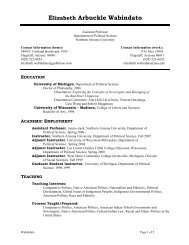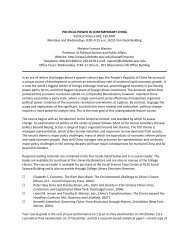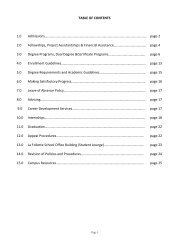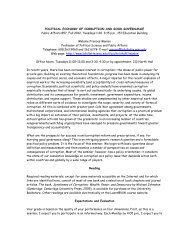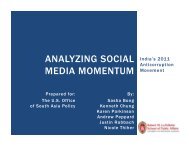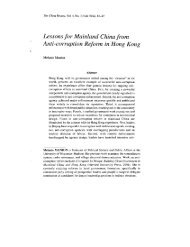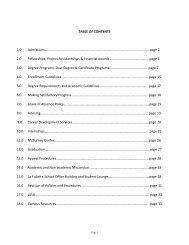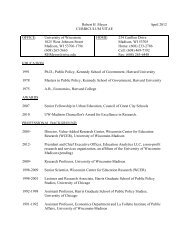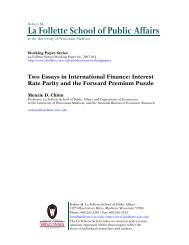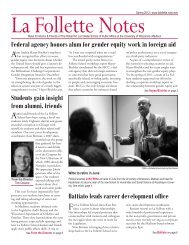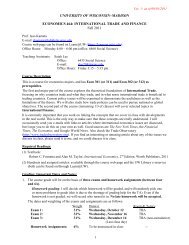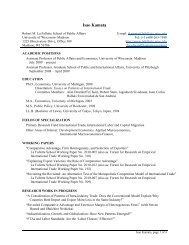SAVE Commission's findings - La Follette School of Public Affairs ...
SAVE Commission's findings - La Follette School of Public Affairs ...
SAVE Commission's findings - La Follette School of Public Affairs ...
Create successful ePaper yourself
Turn your PDF publications into a flip-book with our unique Google optimized e-Paper software.
tee or state agency jurisdictional lines. Among<br />
the problems in the legislative and executive<br />
branches:<br />
£ Excessive delegation without clear<br />
definition <strong>of</strong> policy priorities;<br />
£ Overly stringent implementation<br />
timetables;<br />
£ Under-funded or unfunded expansions<br />
<strong>of</strong> agency<br />
missions;<br />
£ Contradictory<br />
policy goals;<br />
£ No system <strong>of</strong><br />
regulatory<br />
priorities; and<br />
£ Too many bills and too many new laws<br />
with regulatory consequences.<br />
Regulatory reform will be part <strong>of</strong> a performance<br />
budgeting system that focuses on<br />
strategies and results (see Goal #20). Another<br />
tool will be the legislative impact statement (see<br />
Goal #17). As part <strong>of</strong> management reform,<br />
agencies will produce results expected by the<br />
Legislature and will be held accountable.<br />
Reform also will be part <strong>of</strong> the Sweeping<br />
Sunset process (see Goal #16). One stop shopping<br />
could be applied to regulatory permits issued<br />
by state and local governments, especially<br />
to small businesses (see Goal #15).<br />
The Commission found problems in the<br />
technical quality <strong>of</strong> the rules—such as conflicting<br />
legal definitions—and poor enforcement<br />
case preparation. Handling the role <strong>of</strong> the state’s<br />
regulatory ombudsperson will be the existing<br />
Joint Committee for the Review <strong>of</strong> Administrative<br />
Rules. This role will provide an incentive<br />
to agencies to better coordinate and do homework<br />
on enforcement.<br />
Agencies will shift regulatory emphasis<br />
and resources toward more education, more<br />
public involvement and more sharing <strong>of</strong> best<br />
practices. With a focus on prevention, preventive<br />
environmental auditing and innovation,<br />
agencies will find new ideas from business,<br />
communities and citizens. With flexibility, regulators<br />
will applaud<br />
innovations, not resist<br />
them.<br />
Convenient,<br />
quality and consistent<br />
regulatory services<br />
will become<br />
available through<br />
increased pr<strong>of</strong>essional<br />
development, integrated permitting, inter-agency<br />
cooperation and a regulatory circuit<br />
rider system that will issue on-site permits serving<br />
multi-agency functions.<br />
In addition, most far-reaching recommendations<br />
are tied to reinventing citizenship (see<br />
Preamble). Citizens, not regulators, will take<br />
charge <strong>of</strong> the education, environment, public<br />
health and safety in their communities. The<br />
regulatory system misleads us to believe that<br />
government is the sole protector, provider or<br />
pr<strong>of</strong>essional able to achieve social goals. The<br />
reality is that the citizen has the responsibility<br />
and capacity to do what is right. Government<br />
must clearly communicate the goals, <strong>of</strong>fer a<br />
helping hand and applaud results.<br />
“I have seen rules so poorly or<br />
confusingly drafted as to be largely<br />
incapable <strong>of</strong> rational interpretation<br />
and application.”<br />
Chief Appellate Judge William Eich<br />
Footnote: The Commission is grateful to state employees,<br />
businesses, citizens and others who contributed<br />
to the section on regulatory review that<br />
was overseen by the Honorable William Eich <strong>of</strong> the<br />
Wisconsin Court <strong>of</strong> Appeals.<br />
21.7<br />
Use meaningful<br />
participative techniques.<br />
21.8<br />
Create exchanges to<br />
enhance understanding.<br />
21.9<br />
Leverage technology to<br />
enhance participation<br />
and education.<br />
21.10<br />
Create a system <strong>of</strong><br />
regulatory circuit riders.<br />
21.11<br />
Use performance, not<br />
process, for regulatory<br />
systems.<br />
21.12<br />
Set enforcement<br />
priorities.<br />
21.13<br />
Promote regulatory<br />
innovation.<br />
21.14<br />
Promote pr<strong>of</strong>essional<br />
development.<br />
21.15<br />
Coordinate and<br />
reorganizate regulations.<br />
21.16<br />
Create an integrated<br />
permitting system.<br />
21.17<br />
Consolidate agency<br />
field <strong>of</strong>fices and train<br />
staff.<br />
R E S U L T S<br />
Regulating for results<br />
will:<br />
1 Change rules and regulations<br />
so they are user friendly and<br />
results oriented.<br />
2 Respect citizens, businesses<br />
and others as people who want<br />
the right thing done in the right<br />
way.<br />
3 Change regulators from<br />
controllers to coaches.<br />
4 Reform regulations to avoid<br />
contradictory goals, establish<br />
priorities for enforcement, avoid<br />
overly stringent implementation <strong>of</strong><br />
timetables and restrict<br />
underfunded expansions <strong>of</strong><br />
agency missions.<br />
5 Hold agencies accountable for<br />
results expected by the Legislature.<br />
21.18<br />
Create an electronic<br />
system for rule<br />
development and<br />
administration.<br />
21.19<br />
Use environmental<br />
auditing as a tool to<br />
prevent problems.<br />
CITIZEN • COMMUNITY • GOVERNMENT — WISCONSIN: THE 21 ST CENTURY 57



